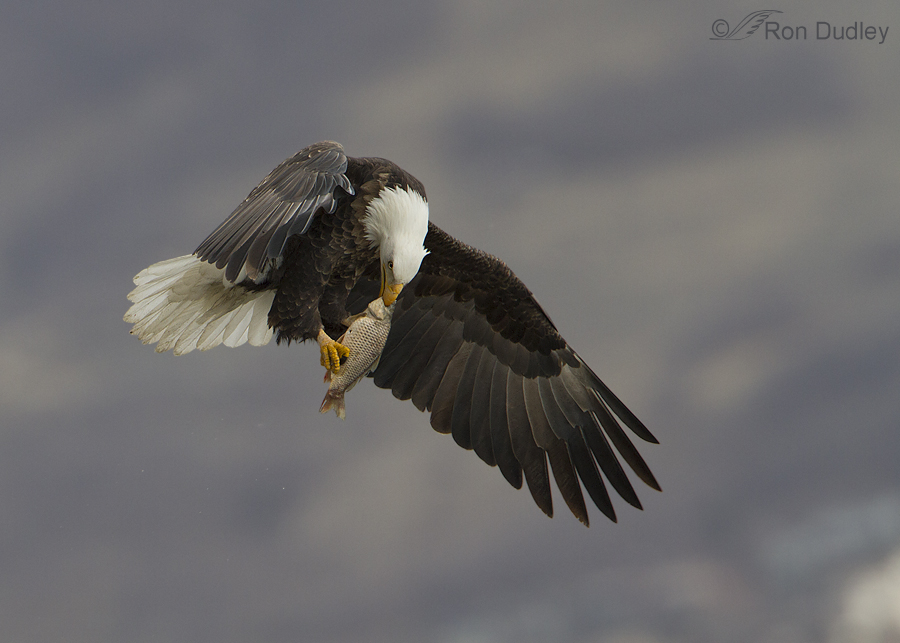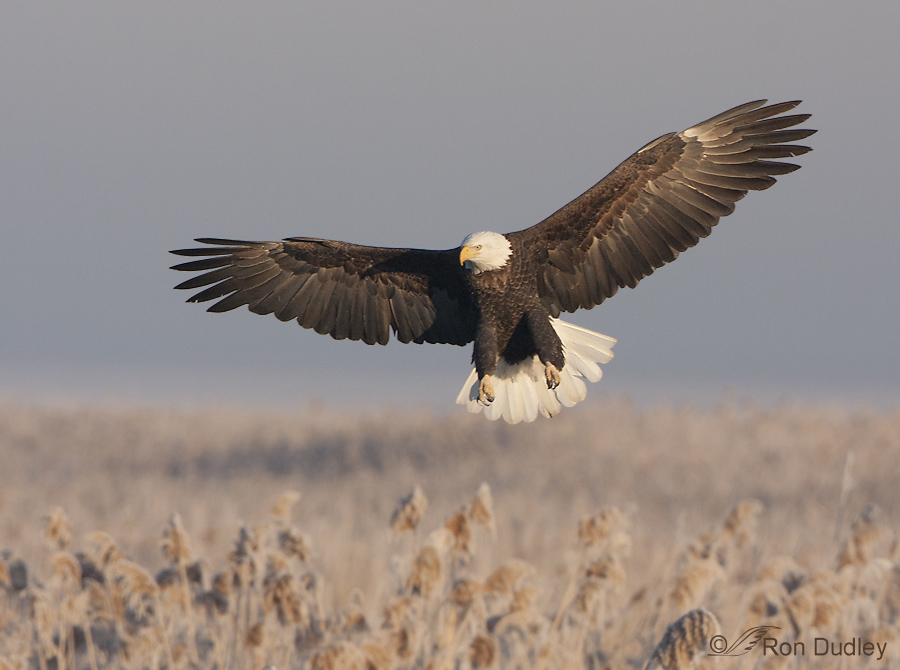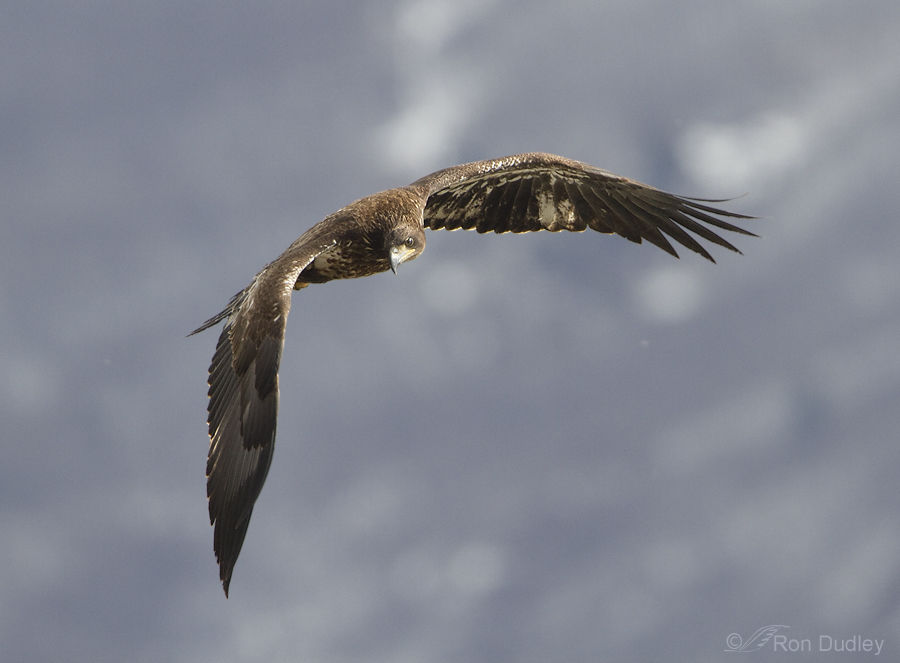Tag: haliaeetus leucocephalus
Bald Eagle Potpourri

Yesterday morning I saw my first Bald Eagle of the season at Farmington Bay. It was too far away for even mediocre images but it was there! We have a small number of resident eagles in northern Utah but those few birds normally don’t hang out at Farmington this early in the season so I’m not sure if it was a wandering resident or an early migrant. Either way it was a delight to see.
As a result, when I began thinking about today’s post my mind kept returning to eagles so I thought I’d present several images taken at Farmington two winters ago.
A Compositional Conundrum – Immature Bald Eagle
A Guide To Aging Bald Eagles
As we go into prime “eagle watching” season here in northern Utah I thought it might be timely to present a guide that would be helpful in aging Bald Eagles as they progress through the 5-6 year process of becoming adults. Many of these younger birds are mistakenly identified as Golden Eagles by the general public. Eagles that have not reached the adult stage are referred to as immature, juveniles or sub-adults. Plumage stages are highly variable, depending on molt sequence, age and timing so other factors like iris and beak color are also taken into account when estimating age. Eyes gradually change from dark brown to yellow while the beak goes from blackish-gray to yellow. 1/4000, f/8, ISO 500, 500 f/4, not baited, set up or called in The adult Bald Eagle is unmistakable with its distinctive bright white head and tail contrasting with the dark brown body and wings. 1/200, f/6.3, ISO 800, 500 f/4, 1.4 tc, not baited, set up or called in But juveniles present very differently than adults, especially in the early stages of development. This very young bird is barely fledged and was still hanging around its nest in sw Montana. Notice that the plumage is dark brown throughout, though they may have some white or pale mottling at this stage – especially on the underparts. Both eye and beak are very dark. 1/2000, f/6.3, ISO 500, 500 f/4, 1.4 tc, not baited, set up or called in This is a first year bird during winter. 1/800, f/8, ISO 500, 500 f/4, natural light,…
Just A Shot That I Like… #29 – Adult Bald Eagle In Flight
Bald Eagles are a winter tradition in northern Utah. Many hundreds of northern birds spend the winter here and for much of that time they’re dispersed over wide areas looking for easy pickings – carrion in particular. But when concentrated food sources become available they can occasionally be found in large numbers. 1/4000, f/8, ISO 500, 500 f/4, natural light This sometimes happens at Farmington Bay Waterfowl Management Area when refuge personnel treat the ponds with rotenone to kill the damaging and invasive carp. When conditions are right, Bald Eagles congregate there for the carp feast. This bird was cruising the area around the second bridge looking for fish. Some years, when temperatures are frigid and other food sources are unavailable, provide great opportunities for birders and photographers but last year wasn’t one of them. The winter was warm and food was available elsewhere so the eagle numbers were down significantly. It will be interesting to see what happens over the next few weeks… Ron
Farmington Bay Bald Eagles 2012 – A Bust!
Farmington Bay Wildlife Management Area is typically a mecca for birders and bird photographers during January and February. When it gets very cold many of Utah’s wintering Bald Eagles congregate there and create quite the spectacle for avian enthusiasts. Though I’m not particularly fond of photographing birds among throngs of people I usually can’t resist the unusual opportunity with these magnificent birds and join in the fray multiple times during the “season”. 1/1250, f/7.1, ISO 500, 500 f/4, 1.4 tc One thing that especially appeals to me about Farmington Bay is the opportunity to photograph these eagles in flight with the Wasatch Mountains as a background. Even though such a background makes it much more difficult for focus to “lock on” the bird I really like the dramatic backdrop the dark, often shaded mountains provide when there’s light on the eagle – much more appealing for me than the typical blue sky background. Typically there are hundreds of eagles at the refuge during “prime time”. I once counted 225 birds and that’s just the ones I could see. Others have reported from 300-400 birds. This photo should give you some idea, though it shows just one small portion of Unit One. The concentration of birds was about the same that day everywhere you looked over the ice. This is the famous “eagle tree”. I’ve seen as many as 20 birds on this one perch alone. Of course the eagles prefer to look south over the ice and water so it’s difficult…
Award Winning Image
Maybe it’s a little tacky of me to toot my own horn but I figured that some of my readers might be interested in this and wouldn’t find out any other way. Yesterday Nature Photographers Network announced the 2011 winners of their annual Editor’s Pick Awards and one of my images won first place in the Avian category. I’ll provide several links below for those who may be interested in seeing my winning photograph and those of the other winners. For those who are unfamiliar with Nature Photographers Network (NPN) it is primarily a nature photography critique site which will explain the critiques below the photos. My image. Be sure to click the “view larger photo” option to see the photo in much better detail. The front page of the NPN Online Magazine, which includes a slide show presentation of the First Place winning images in each of the 9 different categories. Be sure to check them out (hold your cursor over the image to temporarily stop the slide show) as there are some wonderful nature photographs in the presentation. The first, second and third place winning images in each of the nine categories, including the critiques given on each photograph. Ron
Just A Shot That I Like… #11, Bald Eagle In A Dramatic Flight Posture
It’s getting to be that time of year again – Bald Eagle time in Utah! As is typical for this season their numbers in the state are increasing every day. Eagle populations in Utah peak in January and February before many of them start heading north again. 1/1000, f/8, ISO 500, 500 f/4 Though it appears as if this bird was about to snag a fish from the water surface in reality it was simply coming in for a landing on the shore, just out of frame to the lower right. I like the light on the eagle and the overall flight posture. I’m looking forward to freezing my butt off again this winter while photographing these very impressive birds. Ron
Bald Eagle Nictitating Membrane
The nictitating membrane (nictitan) is a membrane or “third eyelid” found in some vertebrates that can be drawn across the eye for protection and to moisten and lubricate the surface of the eye. It is either translucent or semi-transparent so the animal maintains sight while it covers the eye. Birds, sharks and some reptiles have a fully functional nictitating membrane while in most mammals there is only a small vestigial remnant in the corner of the eye. However camels, polar bears, seals, aardvarks, marsupials and monotremes do have fully functional membranes. 1/2000, f/8. ISO 500, 500 f/4, 1.4 tc This nearly adult (head not yet completely white) Bald Eagle is neither tame or captive. But for several days in 2009, beginning on a bitterly cold Christmas morning, this adult adopted a favorite perch (a relatively short pole) that looked out over a pond with fish in it. The pole was so close to the road that I sometimes had to take off my teleconverter to get the entire bird in the frame. It warmed my heart that the eagle was so comfortable with me this close and that was a very good thing because Mia and I almost froze to death over the many hours of photographing this magnificent bird. This is the normal appearance of the Bald Eagle’s eye. In adult birds, eye color is typically some shade of yellow with a distinctly visible pupil (though juvenile birds have much darker eyes). 1/2000, f/8. ISO 500, 500 f/4, 1.4 tc But every few seconds the bird swipes the nictitating membrane across the…
Raptors Mobbing Raptors
Mobbing is an antipredator behavior where animals mob a predator by cooperatively attacking or harassing it. This behavior is especially common in birds during nesting and rearing of young. Typically, it will be a flock of passerines like Red-winged Blackbirds mobbing a raptor or perhaps a magpie or any other bird they consider to be a threat to their nest or young. In mid-June of this year while Mia and I were on another one of our camping/photo forays to Red Rock Lakes National Wildlife Refuge we witnessed a somewhat unusual display of mobbing – raptors mobbing raptors. We had just returned to our camping trailer when Mia noticed this sub-adult Bald Eagle resting on a muskrat mound almost a quarter-mile away across Lower Red Rock Lake – too far away for quality photos (we had marginal light too) but we simply can’t resist training our lenses on a situation like this just to see if something interesting might happen. And this time it did. Canon 7D, 1/800, f/6.3, ISO 500 ev +1.33, 500 f/4, 1.4 tc The eagle seemed to be minding its own business and just hanging out for a while on the mound. Canon 7D, 1/640, f/6.3, ISO 500 ev +1.33, 500 f/4, 1.4 tc But soon a Short-eared Owl (a male I believe) appeared on the scene and he was not happy with the presence of the eagle. My presumption is that the owl had a nest in the area and it felt the eagle threatened the nest or young. Canon 7D, 1/1000, f/6.3, ISO 800 ev +1.00,…
Bald Eagles at Farmington Bay
I paid another visit to Farmington yesterday and while I got some nice shots of a few other species I was reminded of the Bald Eagles that were winter residents out there just a few short months ago. I miss them. So when it turned overcast this morning and I couldn’t go out photographing birds I decided to revisit some of the eagle images I got at Farmington three months ago. Canon 7D, 1/2500, f/7.1, ISO 500, 500 f/4, 1.4 tc This carp may have been an easy catch for the eagle because the water was quite shallow and the fish was likely stunned (though it did appear to still be alive) by the rotenone used to control these fish at the refuge. Canon 7D, 1/2500, f/7.1, ISO 500, 500 f/4, 1.4 tc Both of these images of the eagle with the fish were difficult exposures with the white head facing toward the sun but I liked the action and the good look at the carp. Canon 7D, 1/2000, f/6.3, ISO 500, 500 f/4, 1.4 tc This is one of my better exposures on both the white head and the very dark body and wing plumage in the species. Early morning light certainly helped with that exposure. Canon 7D, 1/1250, f/6.3, ISO 500, 500 f/4, 1.4 tc I like the unusual head turn from this juvenile bird and the Wasatch Mountain background. Canon 7D, 1/4000, f/6.3, ISO 640, 500 f/4, 1.4 tc (wish I’d had lower ISO in this image…



